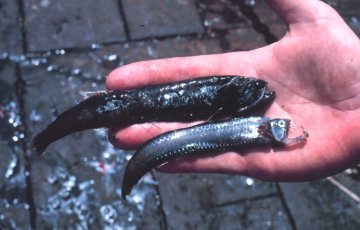The deep ocean is darker than midnight, colder than a chilled martini, and more pressure-packed than Wall Street. But like the strange life form in the sci-fi program "Surface," plenty of organisms find it a comfortable place to live. They've adapted to an environment that's as mysterious as another planet.
 Deep-sea fishes, such as these, generate their own light. Photo: National Oceanic and Atmospheric Administration / Department of Commerce
Deep-sea fishes, such as these, generate their own light. Photo: National Oceanic and Atmospheric Administration / Department of Commerce Deep-sea creatures face several challenges. First, there's no sunlight, so many creatures create their own light. The anglerfish, for example, has a fin on the top of its head filled with light-emitting bacteria. This little lamp lures in other fish, which the angler gobbles up. And the viperfish has a light source inside its mouth; curious fish just swim right in.
The pressure in the deep sea is crushing. At a depth of a thousand meters -- about six-tenths of a mile -- the pressure is a hundred times greater than at sea level. Most creatures at this depth have flexible bones and organs that "give" as they change depth.
Catching food requires special adaptations, too. Much of the food comes in the form of a "rain" of dead fish and other organisms from above. Some deep-water organisms put out a sticky coating to trap this manna from heaven, while others use nets of tentacles. And fish like hagfishes wait for a dead whale or other large creature to fall to the bottom, then burrow inside and eat their way out.
These adaptations create a strange but wonderful mixture of creatures far below the surface of the sea.
copyright 2006, The University of Texas Marine Science Institute.

